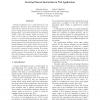105
click to vote
CSFW
2009
IEEE
15 years 7 months ago
2009
IEEE
For most basic cryptographic tasks, such as public key encryption, digital signatures, authentication, key exchange, and many other more sophisticated tasks, ideal functionalities...
115
click to vote
CSFW
2009
IEEE
15 years 7 months ago
2009
IEEE
Abstract. We present aspier – the first framework that combines software model checking with a standard protocol security model to analyze authentication and secrecy properties ...
115
click to vote
CSFW
2009
IEEE
15 years 7 months ago
2009
IEEE
We consider using trust information to improve the anonymity provided by onion-routing networks. In particular, we introduce a model of trust in network nodes and use it to design...
139
click to vote
CSFW
2009
IEEE
15 years 7 months ago
2009
IEEE
One of the important challenges when designing and analyzing cryptographic protocols is the enforcement of security properties in the presence of compromised participants. This pa...
119
click to vote
CSFW
2009
IEEE
15 years 7 months ago
2009
IEEE
Timeout mechanisms are a useful feature for web applications. However, these mechanisms need to be used with care because, if used as-is, they are vulnerable to timing attacks. Th...
CSFW
2009
IEEE
15 years 7 months ago
2009
IEEE
—As networked systems grow in complexity, they are increasingly vulnerable to denial-of-service (DoS) attacks involving resource exhaustion. A single malicious input of coma can ...
114
click to vote
CSFW
2009
IEEE
15 years 7 months ago
2009
IEEE
We present a formal model for modeling and reasoning about security protocols. Our model extends standard, inductive, trace-based, symbolic approaches with a formalization of phys...
104
click to vote
CSFW
2009
IEEE
15 years 7 months ago
2009
IEEE
This paper studies the problem of securing information release in dynamic languages. We propose (i) an intuitive framework for information-release policies expressing both what ca...
CSFW
2009
IEEE
15 years 7 months ago
2009
IEEE
CSFW
2009
IEEE
15 years 7 months ago
2009
IEEE





